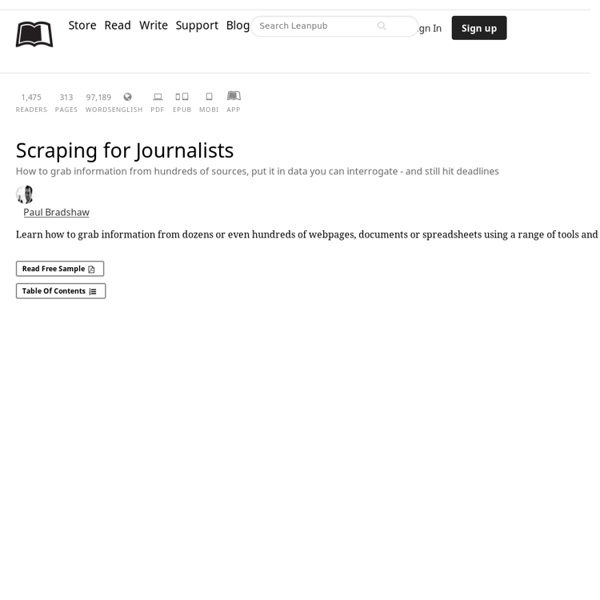Finding Stories in… by Paul Bradshaw
One spreadsheet can tell many stories. You just have to know the right questions to ask. Based on a decade of training journalists and working with news organisations on data-driven stories, Finding Stories In Spreadsheets outlines the techniques for asking the right questions of data using tools like Excel and Google spreadsheets. These aren't just questions about numbers: you'll find out how spreadsheet techniques can help you find the 'needle in the haystack' in text data. With regular examples from journalism and real life data to work with, Finding Stories In Spreadsheets is *full* of those questions, in the language that spreadsheets understand. Cover image concept by @CarolineBeavon.
Jinja2
Jinja2 is a modern and designer friendly templating language for Python, modelled after Django’s templates. It is fast, widely used and secure with the optional sandboxed template execution environment: <title>{% block title %}{% endblock %}</title><ul>{% for user in users %} <li><a href="{{ user.url }}">{{ user.username }}</a></li>{% endfor %}</ul> Features: sandboxed executionpowerful automatic HTML escaping system for XSS preventiontemplate inheritancecompiles down to the optimal python code just in timeoptional ahead of time template compilationeasy to debug. Line numbers of exceptions directly point to the correct line in the template.configurable syntax Additional Information If you can’t find the information you’re looking for, have a look at the index or try to find it using the search function:
Stories and Streams by Paul Bradshaw
Collaborative methods are being increasingly used within the news industry, from Paul Lewis’s investigative work at The Guardian to Neal Mann’s field reporting for Sky, the Farmers’ Weekly team’s coverage of foot and mouth, and Andy Carvin’s coverage of the Arab Spring at NPR. This ebook has been created to support journalism students and tutors in exploring collaborative journalism methods. The book is based on a pilot project called ‘Stories & Streams’ which first ran at Birmingham City University in the 2011-12 academic year. This approach, then, builds on real teaching and learning experiences. The intention is to continue to update this book based on subsequent classes using the method and others' experience with the same methods. For more background you can find a brief project report at the ADM-HEA Networks Magazine with a fuller report forthcoming in a HEA publication on collaborative learning. The three main findings were:
Gunicorn
Organising an Online… by Paul Bradshaw
Journalism has changed: multi-platform, networked, and always on, the modern journalist is expected to be able to write for multiple media across numerous platforms, while collaborating with communities (we used to call them audiences). The investigation team explained in this mini ebook is all about adapting to that change - and challenging everything you thought you knew. Originally written for undergraduate journalism students at Birmingham City University, the five roles in the team are designed to develop a particular aspect of newsgathering and production, from multimedia to community management; data journalism to content curation. These will help you to move beyond the 'news reports' you may be used to producing, and develop a range of new skills for a multiplatform age. Along the way you'll be creating something unique to stand out from the crowd of other aspiring journalists.
HTML5: todas las nuevas etiquetas
HTML5 viene con una buena cantidad de nuevas etiquetas de código así que si eres desarrollador o simplemente quieres empezar a conocerlas apunta, cada elemento de la lista está enlazado a la página de la descripción y modo de uso: Muy pronto vas a empezar a verlas por todas partes, WordPress y sus temas incluidos, así que toma buena nota, hay importantes novedades, sobre todo no pierdas de vista las tags <article>, <nav>, <aside> y <section>. Si quieres empezar a probar códigos aquí tienes una lista de temas WordPress en HTML5: Referencias: w3schools y quackit
Data Journalism Heist by Paul Bradshaw
Data journalism is a key skill for journalists to differentiate themselves in a world where almost anyone can publish, and competition for journalism jobs is fierce. Whether it's hard stories from government spending and MPs' expenses, or softer stories from sports data, fashion trends or music and social activity, our increasingly digital world is providing a rich range of potential new story sources - and new forms of storytelling too. This short ebook introduces you quickly to key techniques in finding that data and turning it into stories - through a 'Data Journalism Heist'. This isn't about the huge investigative projects that you hear about, but the everyday stories that you can do with speed and simplicity. It's about getting in, getting the data, and getting the story out safely. No one gets hurt. In the process you'll learn about: As the book is published you'll receive regular updates as you build on previous skills towards the final story.
Model for the 21st Century… by Paul Bradshaw
In 2007 I published 'A Model for the 21st Century Newsroom', a series of models exploring how journalism might be organised to best play to the strengths of the world that we were now operating in. The physical limitations of traditional newsgathering, production and distribution were now being overcome by digital equivalents. The production line model that had dictated news production for a century was meeting a networked mode of operation where anyone could take on editorial and distribution roles. There were, it seemed, countless opportunities to do journalism in a different way - but very little time, or resources, to find out which ones were most effective. The 21st Century Newsroom, and its accompanying diagram the News Diamond, was adopted and adapted by a number of news organisations in the UK and around the world.
amazon
amazon



